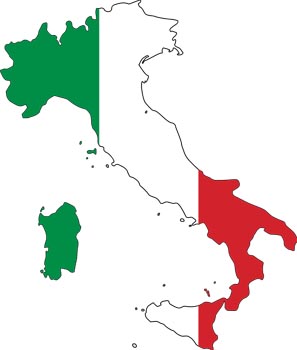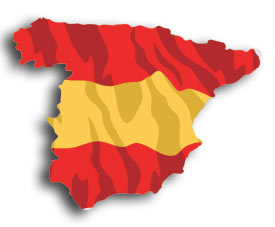Italy has paid heavily for embracing the laissez faire approach for its economy. Amid a dramatic collapse of manufacturing industry, it needs to drop the Anglo-Saxon model and draw some lessons from its own industrial past.
Mine occupations, blockades of roads, air and sea ports, and attempted suicides, this summer saw the most dramatic protests yet in a country that has been rocked by a wave of industry closures as investment escapes economic crisis in the heart of the Eurozone.
Italy’s no.1 industrial company Fiat is rapidly losing interest in the country. Focused on cementing growth in the US market after having bought Chrysler in 2009, last year it shut a plant in Sicily, one of six across the country, and it is threatening to close another. Number two manufacturer Finmeccanica, is looking at selling a host of production units or otherwise to switch off their lights. Ilva, the country’s largest – and one of Europe’s biggest – steel plant, located in the impoverished southern region of Puglia and employer of 12,000 workers, is under threat of closure. So too Italy’s largest aluminium smelter and – if it hadn’t been for some particularly determined resistance by workers that has brought promises of a reprieve – the country’s only coal mine.
These are just the most high profile examples in a grim downward trend that has seen thousands of subcontractors and masses of other smaller companies going to wall in the past 3-4 years, with many more expected to go the same way. Falling industrial orders contributed to the four straight quarters of negative growth in the second quarter of the year, with predictions of a contraction in the overall economy of up 2.4% this year. In total 675,000 industrial jobs – of which 200,000 workers sent home on zero hours under Italy’s cassa integrazione system – have gone up on smoke over the past five years, equivalent to 10% of the industrial base, the CISL union estimates.
The most immediate reason for the meltdown in Italian manufacturing is the global economic crisis that has led to a collapse in demand and the self-defeating austerity measures adopted in response to it. But the seeds of the decline in Made in Italy can be traced back further: to two decades of laissez-faire economics that have sharply reduced Italy’s industrial base, a withdrawal of the state from driving economic development, a privatisation programme that sold off key publicly-owned industrial assets to local and foreign capitalists and an unshakeable faith in the invisible hand of the market.
A bit of history...
Italy’s rise from agricultural back-water to become Europe’s second manufacturing nation after Germany didn’t happen by accident. To the contrary. It was most deliberately engineered by successive governments. It began in the last quarter of the 19th century with large scale state spending, particularly on the navy and railways, backed by protectionist tariff barriers. A second major boost came in the late 1920s and 30s in response to the Great Depression, with the Fascist regime of Benito Mussolini launching a massive public works programme that included draining the Pontine Marshes, hydro-electricity development, railway modernisation, and rearmament, with a new public holding company IRI — Institute for Industrial Reconstruction – mopping up failing companies, leading it to control a significant chunk of the national economy. The third, and most lasting leap forward kicked off in the 1950s, as Italy sought to rebuild itself after the devastation of war.
Central to this task was state monopoly ENI, headed by left Christian Democrat businessman Enrico Mattei. His task was to supply industry in Italy, as the net energy importer, with the fuel to take off. And he did so with flying colours, laying the groundwork for the country’s subsequent Economic Miracle. From the mid 1950s, under Mattei, ENI brought together a rag tag of undercapitalised operations in the energy sector into one group; fought the Anglo-American oil majors and sealed major energy supply contracts with the Soviet Union and the Middle East, (selling Italian chemical, mechanical and textile products and engineering expertise in exchange); it built pipelines bringing fuel to new factories and homes; it created a national network of gas stations, essential to road infrastructure and a subsequent consumer boom led by private car manufacturer Fiat; and it developed a major chemical production sector too. Steel, shipbuilding engineering, aeronautics, railway equipment, telecoms, and even some car manufacturing (Alfa Romeo, subsequently sold to Fiat) also developed at extraordinary rates while in state hands.
None of this was free from controversy. Mattei ruled over a ‘state within a state’ critics said, and he himself was reported to have said of politicians “I use them like I would use a taxi: I sit in, I pay for the trip, I get out”. But his methods were in large part because of powerful lobbies lined up against him, more powerful than the allies he could count on in the Christian Democrat-led governments, controlled by pro-American right wingers.
His strategy of building trade and industrial alliances with the third world and communist countries at the height of the Cold War, breaking the US-UK dominated global oil oligopoly in the process, gained him powerful enemies in the West, particularly in Washington. Italian mafia pentiti claimed their counterparts across the Atlantic had asked them to eliminate Mattei ‘in the interests of the oil largest American companies’. (Mattei died in highly suspicious circumstances in an airplane crash in 1962).
Italy’s private firms were also lined up against him, complaining bitterly that the government was invading their territory. The truth was that most private companies in the country lacked the scale or ambition to invest and innovate. With the exception of the car industry (which however received huge state subsidies over the period) it was only the state that made the kind of investments required to bring Italy up to the first league of manufacturing powers.
All this took place, it is crucial to add, in a context of a rapid rise in prosperity across Western Europe, starting with the boost of the US Marshall plan and then consolidated with the growth of strong welfare states, which provided ready markets for Italy’s burgeoning industries.
Thatcherism & the 1980s
But by the 1980s, the picture had radically changed. Internationally, British prime minister Margaret Thatcher had established a new fashion among western leaders to slash public spending, privatise public assets and deregulate financial markets. This process only accelerated with fall of the Berlin Wall and the collapse of the model in Communist Eastern Europe that placed a central role for the state in the economy. In Europe, integration took a right turn, with a new thrust on competition, a tightening of budgetary rules and a major clamp down on state aid. In Italy, this coincided with a political class that was collapsing under the weight of corruption scandals – in which state-owned companies featured heavily – and which had helped pushed public debt to new highs.
So came, under governments of the right and center-left, a massive sell off of industrial companies to Italians or foreigners alike, or a massive reduction in state shareholdings and role in the most sensitive areas, like energy or military hardware. Yet the record of private enterprise has been dire. The release from the grip of corrupt political parties that used public enterprises to buy votes and fund political campaigns had its advantages. But corruption didn’t go away. It just changed characteristics. Now the dodgy links are between politicians and private, as oppose to state, companies, driven by privatisation and corporate lobbying.
Furthermore, many of the former publicly-owned firms became caught up the financialisation sweeping the West’s corporate world in the noughties, typified by the Parmalat scandal. Investment suffered. Spending as a proportion of GDP fell from 27% in 1980 to 20% in 2010. R&D spending specifically, at 1.1% of GDP in 2011, puts Italy 17th place in Europe. Telecom Italia, privatised in 1997, invested around 60% of its resources in developing its productive capacity and innovation, but that reportedly halved post privatisation. This decline occurred as it become embroiled in a highly controversial hostile takeover by the much smaller computer company Olivetti.
Another disastrous privatisation was the steel industry. The Riva Group took over for a song the huge Ilva steelworks, based in Taranto in the “heel” of Italy: it was supposed to make the investments to fix the plant’s long standing and truly dreadful emissions record. The group did spend some money, but clearly not nearly enough. In July this year, magistrates revealed they had found levels of dioxins and other chemicals pumped from the site they feared may have led to hundreds of deaths in the past 13 years around the city of Taranto, with eight company executives being placed under house arrest over the case. Worse still, Riva group executives are now subject to separate investigations into alleged bribes paid to get environmental reports playing down the scale of pollution at the plant.
Most damning of the record of private enterprise is the fact that since the great sell off growth has collapsed: Italy has become a zombie economy, flatlining for the whole of the 2000s, before the financial crash tipped it into outright recession. Public debt, meanwhile, remains at a historic high of around 120% of GDP.
Furthermore, with the loss of state ownership (particularly the ENI model of the 50s and 60s), followed a loss of an overall vision of where the country should be heading. In short, an industrial strategy. Not perfect by any means, and that includes some appalling environmental legacies it has left, from Ilva to the notorious Porto Marghera chemical plant in Venice. But a strategy that took a long view of what was, overall, in the interests of delivering growth and prosperity in Italy.
Market rules
In handing over the reigns to the markets, Rome abandoned any such vision. For the past two decades, efforts have focused on stimulating a Anglo-Saxon style of capitalism, encouraging Italians to put their plentiful savings into Italy’s stocks and shares, or private pension funds, and creating independent watchdogs to regulate ‘competitive’ markets, even if in practice they are, like Italy’s motorways, a natural monopoly now in the hands of privateers.
As Giuseppe Berta, a professor in economic history, argues: “After a century in which Italy has developed its own unique model, a break in the way we see industrial development occurred. In the eighties it was decided that it was necessary to adapt models from abroad, primarily from the Anglo-Saxon countries, with the absolute prevalence of private activity. The result was that the growth was interrupted…And yet we already have another historical experience that shows us that that choice was wrong.“
The drive to emulate Britain and America’s laissez faire model continues, encouraged by pro-market international organisations such as the OECD and IMF. In the mid-2000s, corporate tax rates were cut, from 37% to 31%. And a new wave of ‘supply-side’ economics has been launched by prime minister and former European Commissioner Mario Monti, opening up protected professions, like lawyers, pharmacists and taxi drivers, and deregulating labour markets to make it easier to hire and fire, all on very thin and often contradictory evidence that this boosts efficiency, cuts prices and so lifts growth rates.
The experience of the last wave of deregulation in Italy certainly doesn’t back this theory up. And yet more public assets, including some real treasures of Italy’s heritage, are being prepared for sale as part of a bid to offload hundreds of billions in government-owned real estate. Of course, times have changed and, to misquote Marx, history doesn’t repeat itself, unless as a farce. Which is perhaps what the unprecedented bail outs of banks, to not obviously useful effect, could be called.
What the years since the 2007-8 financial crisis hit have shown us, however, is that state intervention is very much back in vogue. The problem is that it is confined to financial institutions that are not lending at all now, and (outside of Germany) have never seen the real economy as a priority.
Unions, in increasing alarm about the scale of ‘social butchery’ in their country, have been stepping up their demands for government action. Susanna Camusso, general secretary of the country’s largest trade union central, CGIL, argues that the government has to pull its finger out and if that means taking stakes in failing companies or plants threatened with closure in order to protect jobs, skills and strategically important sectors then so be it.
Alternative Industrial Strategy
So what should an industrial strategy for Italy look like? A huge boost to infrastructure, currently favourite among governments across the globe and under consideration by Mario Monti, may not be a great idea, if it turns into a plan to concrete over yet more of Italy’s fast receding green land, or ends up feeding the Mafia’s insatiable appetite for large construction projects.
But as part of a sustainable greening of the economy – and this should include an acceleration of the existing solar power programme that currently faces cutbacks – infrastructure, equipment and vehicles for a badly needed integrated public transport system could provide a good number of orders for local manufacturers. Among them Fiat, which needs like to adapt to the fact that Italians have enough cars, which instead need to be reigned back in the interests of people’s health and Italy’s suffering medieval cities.
Although not strictly an industrial matter, by renovating, restoring and cultivating the country’s stunning natural environment and crumbling heritage, instead of selling it off, Italy could maintain and upskill millions of jobs in tourism, which successive governments have consistently failed to exploit to its full.
A thread driving through any strategy must be to give priority over local production to protect jobs, particularly in deprived areas and where there is a real local need, such is case of the smelter in Italy’s poorest province, Iglesias-Carbonia in Sardinia. It faces closure because the American owner, Alcoa, a global giant, having pocketed billions in subsidies no longer sees a profit in it. And yet Italy has to had import up to 90% of its aluminium requirements.
Public investment
Finally, in any new industrial blueprint for Italy, there is surely an expanded role for the country’s deeply rooted co-operative movement. But above all, strong public investment and direction is required.
Money could certainly be found for a more muscular industrial strategy. Despite a huge debt mountain exceeding €2 trillion or some 120% of GDP, private wealth stands at €8.6 trillion. The proportion of Italians sitting on assets in excess of $100,000 is four times higher than the global average, while 3 million families are in the top 1% of global wealth distribution. A moderate tax on this wealth could bring up to €15 billion annually into the state coffers.
Yet a wealth tax has been continually knocked back by successive governments while action on tax evasion – mounting to as much as €180 billion a year – came under criticism yet again from the EU earlier this year.
Furthermore, a proper plan for industry is not compatible with Europe’s current austerity fetish, which has restricted pubic spending and required taxes that kill mass consumption. Nor can it work in an environment of free roaming capital, which is feeding speculation driving up government borrowing costs to record levels, nor competition law that favours foot-loose multinationals that come and go at will. Nor the Euro single currency, which by an effective devaluation of the Deutschmark has meant the regional superpower Germany has become devastatingly competitive vis a vis its weaker neighbours, Italy included.
In a bizarre exhibition of self-delusion Mario Monti recently declared that he could see ‘light at the end of the tunnel.’ He doesn’t see it but Italy is in serious danger of an early industrial death. That’s because, with eyes looking for cues from the enemies of economic development in the international banks and other speculators, Monti, and the rest of the political class, have a blind spot for this particular aspect of Italy’s history. But it is an industrial past that Italy needs to rediscover.





An industrial strategy alone wil not suffice or save Italy from the downward spiral that has been created by he models outlined in the article. Nothing less than a new way of living and working will suffice and I suspect that getting the genie back in the bottle will be difficult. The Anglo-Saxon model clearly does not work for Italy but it also does not work for the Anglo-Saxons. The UK is in the proverbial also just not as obvious as Italy. I suspect that we have a way to go yet before radical solutions will become accepted and we can develop models that suit individual countries needs. This cannot be met under current EU structures. I struggle to see a single solution to this problem and as a European I feel a great sense of despair at opportunities lost and squandered to reshape our futures in a progressive way.
Posted by Cyril Wheat | September 13, 2012, 2:32 pm